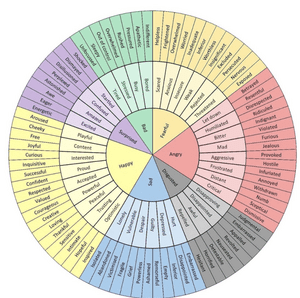One of the areas that I’m working on with my therapist is emotional regulation. Emotional regulation refers to the ability to manage and control one’s emotions healthily and constructively. It involves the capacity to understand, express, and modulate one’s feelings, so they are appropriate to the situation and do not lead to impulsive or disruptive behaviors. Effective emotional regulation is crucial for maintaining stable relationships, making sound decisions, and coping with life’s challenges.

Emotional regulation can be challenged by various factors, including biological predispositions. Some individuals may have a genetic or neurological predisposition that makes it more difficult for them to regulate their emotions effectively, leading to heightened emotional reactivity. Additionally, a lack of emotional regulation skills can impede one’s ability to manage feelings, as many people may not have learned or developed healthy coping strategies. Reinforcement of emotional behaviors, through past experiences or learned responses, can further complicate matters by perpetuating maladaptive emotional reactions. Moodiness, which can result from external stressors or internal factors, may undermine one’s emotional stability, making it challenging to maintain consistent regulation. Emotional overload, such as being inundated with a multitude of emotions at once, can overwhelm an individual’s capacity to regulate effectively. Lastly, the perpetuation of emotion myths and misconceptions, like the idea that certain emotions are inherently negative or weak, can hinder one’s ability to acknowledge and manage their feelings healthily. Addressing these challenges often involves education, practice, and a willingness to confront and reevaluate one’s beliefs about emotions.
Myths
One common myth is the belief that certain emotions are inherently negative or weak, while others are positive or strong. In reality, all emotions serve a purpose and are essential for the human experience, with each offering valuable insights and motivating behaviors.
Another myth is that emotional regulation means suppressing or denying one’s feelings. In truth, emotional regulation involves acknowledging and accepting emotions rather than burying them. Suppressing emotions can lead to emotional bottling and potential outbursts, making it crucial to find healthy ways to express and process one’s feelings.
There’s also a misconception that emotional regulation implies always maintaining a calm and composed demeanor. While composure is essential in certain situations, it is natural to experience moments of intense emotion, and it’s acceptable to express those feelings in appropriate contexts. Emotional regulation involves finding a balance between expressing emotions and maintaining self-control.
A common myth related to emotional regulation is the idea that it should be effortless and that one should be able to control their emotions at all times. In reality, emotional regulation is a skill that may require practice and learning, and everyone has their unique emotional triggers and challenges.
These myths can contribute to unrealistic expectations and unnecessary guilt when it comes to emotional regulation. It’s essential to debunk these misconceptions and instead foster a more comprehensive understanding of emotions and how to manage them healthily and adaptively.
The Emotional Wheel

One of the tools we use in therapy is The Emotion Wheel. The emotion wheel, also known as the “wheel of emotions” or “feelings wheel,” is a visual tool used to categorize and represent a wide range of human emotions. It typically consists of a circular diagram with various emotions or feeling words arranged in a systematic pattern. The wheel helps individuals identify and differentiate between nuanced emotional states, making it a valuable resource for emotional intelligence, communication, and self-awareness. By providing a structured framework for understanding and expressing emotions, the emotion wheel aids in the development of emotional regulation skills and can enhance interpersonal relationships and emotional well-being.
Prompting Events
One area that I need to bring more awareness to is Prompting Events. Prompting events are external or internal stimuli that initiate or trigger emotional responses and behaviors in individuals. These events can be diverse and encompass a wide array of circumstances, experiences, or thoughts that lead to the activation of specific emotions. For example, a compliment from a friend may prompt feelings of happiness and self-esteem, while receiving constructive criticism could trigger feelings of defensiveness or self-doubt. Likewise, external events like an unexpected promotion at work can prompt excitement and pride, while news of a personal loss might prompt grief and sadness.
Understanding prompting events is a crucial aspect of emotional regulation and self-awareness. By identifying the specific events or triggers that lead to certain emotional responses, individuals can develop strategies to manage their reactions effectively. It allows for a proactive approach to emotional regulation, enabling individuals to anticipate and prepare for emotionally challenging situations and to engage in constructive responses to prompting events, ultimately promoting emotional well-being and healthier relationships.
In order to change and regulate emotional responses effectively, several strategies can be employed, including checking the facts, using Opposite Action, and engaging in problem-solving.

- Check the Facts: Checking the facts involves critically assessing the accuracy and validity of the thoughts and beliefs that underlie your emotional responses. Often, strong emotions are triggered by automatic, negative thought patterns that may not be based on reality. By examining the evidence and seeking a balanced perspective, you can challenge irrational or exaggerated beliefs. For example, if you’re feeling anxious about an upcoming presentation, checking the facts might involve recognizing that you have prepared adequately and have successfully delivered presentations in the past, thus reducing unnecessary anxiety.
- Use Opposite Action: Opposite Action is a technique commonly associated with Dialectical Behavior Therapy (DBT) and is useful for managing emotions, particularly when the emotional response doesn’t match the situation. It entails deliberately acting in a manner opposite to the emotional impulse you’re experiencing. For instance, if you feel like withdrawing from social interactions due to social anxiety, Opposite Action would encourage you to engage with others and participate in social events. This approach can help recalibrate your emotional response by sending a signal to your brain that the emotion is not warranted in the given context.
- Problem Solve: In some situations, changing emotional responses may require addressing the underlying issues or stressors causing the emotions. Problem-solving involves identifying the specific problems or challenges contributing to your emotional distress and working towards practical solutions. For example, if you’re feeling overwhelmed by a heavy workload, you can break tasks into manageable steps, delegate when possible, or seek support to alleviate the stress. By actively addressing the root causes of emotional distress, you can reduce the intensity and frequency of negative emotional responses.
These strategies are valuable tools in the toolkit of emotional regulation, offering practical ways to navigate and modify emotional responses in a healthier and more adaptive manner. They empower individuals to take control of their emotions and make more informed choices in their responses to various situations and challenges.
Deciding whether to use Opposite Action or Problem-Solving depends on the context. If the emotion is unwarranted or excessive for the situation, Opposite Action can be a helpful tool for immediate relief and emotional recalibration. However, if the emotion is directly linked to a concrete problem or stressor, Problem-Solving is often the more appropriate choice, as it aims to resolve the underlying issue and create a foundation for more consistent emotional well-being. In practice, a combination of these strategies may be used, as emotional regulation often involves a dynamic interplay between recognizing emotions, managing their immediate impact, and addressing the root causes for long-term emotional health.

There was a lot of emotional “baggage” to unpack in this blog post. Let some of this marinade for a bit and then we’ll continue. The packet I have is quite extensive, so I’ll be back to post some more on this topic.
Discover more from Whispers of Insight
Subscribe to get the latest posts sent to your email.



One comment on “Emotional Regulation”